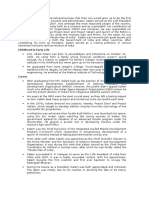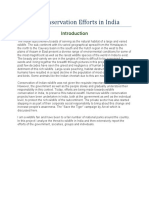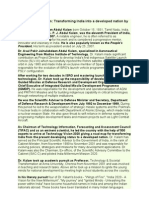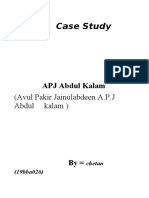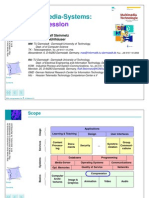Historyproject 220314181557
Historyproject 220314181557
Uploaded by
V.HariharanCopyright:
Available Formats
Historyproject 220314181557
Historyproject 220314181557
Uploaded by
V.HariharanOriginal Title
Copyright
Available Formats
Share this document
Did you find this document useful?
Is this content inappropriate?
Copyright:
Available Formats
Historyproject 220314181557
Historyproject 220314181557
Uploaded by
V.HariharanCopyright:
Available Formats
DR. A.P.J.
ABDUL KALAM – THE MISSILE MAN OF INDIA
Dr. A.P.J. Abdul Kalam was a prominent Scientist and 11th
president of India. He was also known as the Missile Man of
India. He was honoured with several prestigious awards
including India's highest civilian honour Bharat Ratna in
1997.
Dr. A.P.J. Abdul Kalam – The Missile Man of India
Name : Avul Pakir Jainulabdeen Abdul Kalam (Dr. A.P.J. Abdul
Kalam)
Nick Name : Missile Man
Nationality : Indian
Occupation : Engineer, Scientist, Author, Professor, Politician
Born : 15-Oct -1931
Place of Birth : Dhanushkodi, Rameswaram, Tamil Nadu, India
Died : 27 July 2015
Died at the age of : 83
Place of Death : Shillong, Meghalaya, India
Famous as : Dr. A.P.J. Abdul Kalam President from 2002 to 2007
Preceded by : Kocheril Raman Narayanan (President from 1997-
2002)
Succeeded by : Pratibha Patil (President from 2007-2012)
Avul Pakir Jainulabdeen Abdul Kalam also known as Dr. A.P.J
Abdul Kalam. He was born in Dhanushkodi, Rameswaram, Tamil
Nadu and studied physics and aerospace engineering.
He was the 11th president of India and elected against
Lakshmi Sehgal in 2002. Before becoming the President of India,
he worked with the Indian Space Research Organisation (ISRO) and
Defence Research and Development Organisation (DRDO) as an
aerospace engineer.
He was known as the Missile Man of India for his important
role in the nation's civilian space programme and military missile
development. Also, in 1998, he made significant contributions to
India's Pokhran-II nuclear tests.
He had also served as the project director of India's first
Satellite Launch Vehicle (SLV-III) at ISRO.
In 1990s he had served as the Chief Scientific adviser to the
Prime Minister before becoming the President of India in 2002.
Now, let us study about Dr. A.P.J Abdul Kalam in detail through
this article.
A.P.J Abdul Kalam: Family history and early life
Dr. A.P.J Abdul Kalam was born on 15 October, 1931 to a
Tamil Muslim family in Rameswaram, then in Madras Presidency
in British India and now in Tamil Nadu. His father name was
Jainulabdeen, who was a boat owner and imam of a local mosque.
His mother name was Ashiamma, who was a housewife.
Abdul Kalam was the youngest of five siblings, the eldest was
a sister, namely Asim Zohra and three elder brothers, namely
Mohammed Muthu
Meera Lebbai Maraikayar, Mustafa Kalam and Kasim Mohammed.
He was close to his family and always helps them, though he
remained a bachelor whole life.
His ancestors had been wealthy traders and landowners, with
numerous properties and large tracts of land. They trade groceries
between the mainland and the island to and from Srilanka and also
ferrying the pilgrims from mainland to the Pamban Island. So,their
family got the title "Mara Kalam Iyakkivar" (wooden boat steerers)
and later known as "Marakier."
But by 1920s, his family had lost most of his fortune; their
businesses failed and by the time Abdul Kalam was born are in the
stage of the poverty-stricken. To help the family, Kalam started
selling newspapers at an early age.
In his school days, Kalam had average grades but was
described as a bright and hardworking student who had a strong
desire to learn. Mathematics was his main interest.
He had competed his matriculation from Schwartz Higher
Secondary School, Ramanathapuram and later he went to Saint
Joseph's college where he became a physics graduate. In 1955, he
went to Madras to study aerospace engineering in Madras Institute
of Technology.
During his third year of graduation, he was assigned a project
to design a low-level attack aircraft together with a few other
students. Their teacher had given them a tight deadline for
completing the project, it was very difficult. Kalam worked hard
under immense pressure and finally completed his project within
the stipulated deadline. The teacher was impressed by the
dedication of Kalam.
As a result Kalam want to become a fighter pilot but he got
9th position in the qualifiers list and only eight positions were
available in the IAF.
A.P.J Abdul Kalam: Education and Career
A.P.J Abdul Kalam had completed his graduation in 1957
from the Madras Institute of Technology and in 1958 as a scientist
he had joined the Aeronautical Development Establishment of the
Defence Research and Development Organisation (DRDO).
In the early 1960s, he worked with the Indian National
Committee for Space Research (INCOSPAR) under the renowned
space scientist Vikram Sarabhai.
He had started his career by designing a small hovercraft at
DRDO.
After visiting NASA's Langely Research Centre in Hampton,
Virginia; Goddard Space Flight Centre in Greenbelt, Maryland and
Wallops Flight Facility in 1963-64, he had started working on an
expandable rocket project independently in 1965 at DRDO.
He was not much satisfied with his work at DRDO and when
he received transfer orders to the ISRO in 1969 he became happy.
There he served as the project director of the SLV-III which
successfully deployed the Rohini satellite in near-earth orbit in July
1980. It is India's first indigenously designed and produced satellite
launch vehicle.
Kalam received the government's approval in 1969 and
expanded the programme to include more engineers. In 1970s, he
had made an effort to develop the Polar Satellite Launch Vehicle
(PSLV) with an aim to allow India to launch its Indian remote
Sensing (IRS) satellite into Sun-Synchronous orbit, PSLV project
was successful and on 20 September 1993, it was first launched.
In 1970s, Abdul Kalam directed two projects namely Project
Devil and project Valiant. It was an early liquid-fuelled missile
project aimed at producing a short-range surface-to-air missile. This
project was not successful and discontinued in 1980s and later it led
to the development of the Prithvi missile. On the other hand
Project Valiant aimed at the development of intercontinental
ballistic missile. This was also not successful.
An Indian Ministry of Defence programme managed by
DRDO in partnership with other government organisations
launched the Integrated Guided Missile Development programme
(IGMDP) in the early 1980s. Abdul Kalam was asked to lead the
project and in 1983 he returned to DRDO as Chief Executive of
IGMDP in 1983.
The programme led to the development of four projects
namely Short range surface-to-surface missile (Prithvi), Short range
low-level surface-to-air missile (Trishul), Medium range surface-to-
air missile (Akash) and Third-generation anti-tank missile (Nag).
Under the leadership of Abdul Kalam, the project of IGMDP
proved to be successful by producing missiles like first Prithvi
missile in 1988 and then the Agni missile in 1989. Due to this he
was known as "Missile Man of India."
In 1992, he was appointed as the Scientific Adviser to the
Defence Minister. With the rank of cabinet minister, in 1999, he was
appointed as the Principal Scientific Adviser to the Government of
India.
Abdul Kalam played a major role in conducting the Pokhran-
II, a series of five nuclear bomb test explosions in May 1998. With
the success of these tests he got the status of a national hero and
then Prime Minister Atal Bihari Vajpayee declared India a full-
fledged nuclear state.
Not this much, A.P.J. Abdul Kalam in 1998 proposed a
countrywide plan called Technology Vision 2020 to make India a
developed nation by the year 2020 and suggested nuclear
empowerment, various technological innovations, improvement of
agricultural productivity etc.
In 2002, the National Democratic Alliance (NDA) was in
power and nominate Dr. A.P.J. Abdul Kalam for the post of the
President of India. Being a popular national figure, he won the
presidential election easily.
A.P.J. Abdul Kalam as a President of India (2002 to 2007)
On 10 June 2002, the NDA government proposed Dr. A.P.J.
Abdul Kalam name for the presidential post to the Leader of
opposition, Congress President Sonia Gandhi.
Dr. Abdul Kalam served as the President of India from 25 July
2002 to 25 July 2007. He was the first scientist and the first
bachelor to occupy the Rashtrapati Bhawan.
He became the 11th President of India by succeeding K.R
Narayanan.
He received the prestigious Bharat Ratna and became the
third President to receive the highest civilian honour after Dr.
Sarvapali Radhakrishnan in 1954 Dr. Zakir Hussain in 1963.
Dr. Abdul Kalam was also known as People's President.
According to Dr. Kalam, the toughest decision taken by him
as the President was signing the bill of office of Profit.
Over the course of his five-year term, he remained committed
to his vision of transforming India into a developed nation.
He was however criticised for his inaction to decide the fate of
20 mercy petitions out of 21, including that of the Kashmiri
Terrorist Afzal Guru, who was convicted for the parliament
attacks in December 2001.
He decided not to contest the Presidential election again in
2007 and stepped down as the president on 25 July 2007.
A.P.J. Abdul Kalam: Post Presidency
After leaving the office, Dr. Abdul Kalam chosen the
academic field and became a visiting professor at the Indian
Institute of Management Shillong, the Indian Institute of
Management Ahmedabad, the Indian Institute of Management
Indore, an honorary fellow of the Indian Institute of Science,
Bangalore.
He also served as the chancellor of the Indian Institute of
Space Science and Technology Thiruvananthapuram, professor
of Aerospace Engineering at Anna University and an adjunct at
many other academic and research institutions across India.
The information technology was also taught by him at the
International Institute of Information Technology, Hyderabad,
and technology at Banaras Hindu University and Anna
University.
In 2011, he was criticised by civil groups over his stand on
Koodankulam Nuclear Power Plant as he had supported the
establishment of the nuclear power plant and was accused of
not speaking with the local people.
'What Can I Give Movement' a programme launched by Dr.
Abdul Kalam for the youth of India with a central theme of
defeating corruption.
A.P.J. Abdul Kalam: Death
On 27 July 2015, Dr. Abdul Kalam was delivering a lecture at
IIM Shillong where he suffered a heart attack and his condition
became critical, so, he was shifted to Bethany Hospital where
thereafter, he died of cardiac arrest. His last words, to Srijan Pal
Singh, were "Funny guy! Are you doing well?"
On 30 July, 2015, the former President was laid to rest at
Rameshwaram's Pei Karumbu Ground with State honours.
A.P.J. Abdul Kalam National Memorial
In the memory of late President Dr. A.P.J Abdul Kalam a
memorial was built on his name at Pei Karumbu, in the island town
of Rameswaram, Tamil Nadu, India. On 27 July, 2017 It was
inaugurated by the Prime Minister of India, Narendra Modi.
In the memorial various replica of rockets and missiles are
kept which shows the work of Dr. Abdul Kalam. Also, some acrylic
paintings about his life are also displayed along with hundreds of
portraits which depict the life of Dr. Kalam.
At the entrance of the memorial a statue of Dr. A.P.J. Abdul
Kalam was placed showing him playing Veena a musical
instrument. With this two more statues are there in sitting and
standing posture.
A.P.J. Abdul Kalam: Awards and Achievements
- In 1981, Dr. Kalam received Padma Bhushan from the
Government of India.
- In 1990, Dr. Kalam received Padma Vibhushan from Government
of India.
- In 1994 and 1995, Distinguished Fellow and Honorary Fellow by
Institute of Directors India and National Academy of Medical
Sciences.
- In 1997, he had received Bharat Ratna from Government of India
and Indira Gandhi Award for National Integration from Indian
National Congress.
- In 1998, Veer Savarkar Award from Government of India.
- In 2000, Ramanujan Award from Alwars Research Centre,
Chennai.
- In 2007, he was honoured with the King Charles II Medal by the
Royal Society, U.K. and Doctorate of Science from University of
Wolverhampton, UK.
- In 2008, he won the Hoover Medal given by ASME Foundation,
USA and received Doctor of Engineering by Nanyang
Technological University, Singapore.
- In 2009, The California Institute of Technology, U.S.A, presented
Kalam with the International von Karman Wings Award, Hoover
medal by ASME Foundation, USA and Honorary Doctorate by
Oakland University.
- In 2010, Doctor of Engineering by University of Waterloo.
- In 2011, The IEEE honoured Kalam with IEEE Honorary
Membership.
- In 2012, Doctor of Laws by Simon Fraser University.
- In 2013, Von Braun Award by the National Space Society.
- In 2014, Doctor of Science by the Edinburgh University, UK.
- Following his death, he received several tributes like the Tamil
Nadu State Government on 15 October that is on his birthday
announced to observe across the state as “Youth Renaissance Day”.
Further the State Government instituted the Dr. A.P.J Abdul Kalam
Award constituting an 8 gm gold medal, a certificate and Rs
500,000.
- On an Independence Day, from 2015, the award will be awarded
annually to the residents of the state with the achievements in
promoting scientific growth, the humanities or the welfare of
students.
- Also, the CBSE on the anniversary of Dr. Kalam’s birth set some
topics on his name in the CBSE syllabus or expression series.
- Not only this, on 15 October, 2015 the 84th anniversary of Kalam’s
birth, Narendra Modi, the Prime Minister of India released postage
stamps commemorating Kalam at DRDO Bhawan in New Delhi.
- A new bacterium as the filters of the International Space Station
(ISS) named it as Solibacilus Kalami to honour the late President
Dr. Abdul Kalam was discovered by the Researchers at the NASA
Jet Propulsion Laboratory.
A.P.J. Abdul Kalam: Legacy
As we know that Dr. Abdul Kalam was the youngest child in
his family and was close to his parents and his brothers and sisters.
He never married and served his relatives whole life. No doubt he
was a very simple person with simple lifestyle. He owned a few
possessions including veena and collection of books. He was a kind
hearted man, a vegetarian and consumed simple food.
According to S.M Khan who was close to Dr. Abdul Kalam
wrote a book The Peoples President on Abdul Kalam says "He lived
the life of a true Muslim but had high respect for all other religions
and believed that humanism is the biggest quality of a human
being. “He would perform namaaz everyday but also read Bhagwat
Gita. Playing veena has nothing to do with religion. For him
religion was a personal matter and used to emphasise that one
should not make it a matter of pomp and show. He used to say in
your dealings with the society you have to be a humanist. Dr.
Kalam often used to cite the story of how his mentor Vikram
Sarabhai asked for church land for scientific research and got it
because the bishop believed that both science and spirituality seek
the Almighty’s blessings for human prosperity, mind and body."
A.P.J. Abdul Kalam: Educational and Scientific Institutions
Various educational, scientific institutions and some locations are
named in honour of Dr. Abdul Kalam. They are as follows:
On the day of Kalam's funeral, An agricultural college at
Kishanganj, Bihar was renamed as the "Dr. Kalam Agricultural
College, Kishanganj" by the Bihar State Government.
Uttar Pradesh Technical University (UPTU) was renamed
"A.P.J. Abdul Kalam Technical University" by the Uttar Pradesh
state government.
A.P.J. Abdul Kalam Memorial Travancore Institute of
Digestive Diseases, a new research institute in Kollam city, Kerala
attached to the Travancore Medical College Hospital.
In September 2014, India and US have launched the
Fulbright-Kalam Climate Fellowship. The fellowship will be
operated by the binational US-India Educational Foundation
(USIEF) under the Fulbright programme.
Kerala Technological University, headquartered at
Thiruvananthapuram where Kalam lived for years, was renamed
to A.P.J. Abdul Kalam Technological University after his death.
You might also like
- Life Sketch of Dr. Apj Abdul Kalam and His Contribution To EducationDocument9 pagesLife Sketch of Dr. Apj Abdul Kalam and His Contribution To Educationamrit3883% (137)
- History ProjectDocument9 pagesHistory ProjectShourya90% (10)
- History ProjectDocument17 pagesHistory ProjectANSHIT GUPTA33% (6)
- Maths Project: Name: Anshit Gupta Class: X Sec.: A (Commerce) Roll No.: 7Document22 pagesMaths Project: Name: Anshit Gupta Class: X Sec.: A (Commerce) Roll No.: 7Harish GNo ratings yet
- DR APJ Abdul Kalam Life Sketch and ContributionsDocument12 pagesDR APJ Abdul Kalam Life Sketch and ContributionsKarthik Krishna100% (21)
- Importance of Transport in IndiaDocument5 pagesImportance of Transport in IndiaJay Malaney100% (2)
- History Priject Pakka FinalDocument15 pagesHistory Priject Pakka FinalThe Munning Guy60% (5)
- 1.survey of Various Types of Bank Accounts, Rate of Interest OfferedDocument40 pages1.survey of Various Types of Bank Accounts, Rate of Interest Offeredchiranth50% (2)
- Wildlife ConservationDocument30 pagesWildlife ConservationKarthika100% (5)
- 10th Icse Project Wildlife Conservation Efforts in IndiaDocument11 pages10th Icse Project Wildlife Conservation Efforts in Indiatanmay97% (33)
- Icse Mathematics Project: Class-10Document13 pagesIcse Mathematics Project: Class-10Manju Yadav67% (3)
- History ProjectDocument9 pagesHistory ProjectShouryaNo ratings yet
- Early LifeDocument5 pagesEarly Lifesimran khiroria100% (1)
- Childhood & Early LifeDocument3 pagesChildhood & Early Lifekunjap100% (1)
- Dr. A. P. J. Abdul Kalam (His. Project)Document15 pagesDr. A. P. J. Abdul Kalam (His. Project)Patel ShailNo ratings yet
- Apj Abdul Kalam ProjectDocument6 pagesApj Abdul Kalam ProjectMridulNo ratings yet
- Life Sketch and Contibutions of APJ Abdul KalamDocument12 pagesLife Sketch and Contibutions of APJ Abdul KalamAnush B H100% (2)
- Early LifeDocument7 pagesEarly LifeRamanaa VijayakumarNo ratings yet
- Apj Abdul KalamDocument17 pagesApj Abdul KalamKapil Rawat100% (1)
- Works and Achievements of Malala YousafzaiDocument7 pagesWorks and Achievements of Malala YousafzaiVAISHNAVI REDDY100% (4)
- Apj Abdul KalamDocument4 pagesApj Abdul KalamBalaji Rao N100% (2)
- Rail - Road - Air and Water Transport Routes in IndiaDocument7 pagesRail - Road - Air and Water Transport Routes in IndiaMihir Jichkar100% (13)
- Math Final Project On BudgetDocument13 pagesMath Final Project On BudgetMeenakshi Yadav33% (3)
- Geography Project 1Document6 pagesGeography Project 1Amar Mane67% (9)
- Wildlife Conservation Efforts in IndiaDocument6 pagesWildlife Conservation Efforts in IndiaPonvel Kumaran K BNo ratings yet
- Dadabhai Naroji Poverty and Unbritish Rule in IndiaDocument14 pagesDadabhai Naroji Poverty and Unbritish Rule in Indiaamartya63% (8)
- Wildlife Conservation Efforts in IndiaDocument12 pagesWildlife Conservation Efforts in IndiaSushant Dwivedy69% (35)
- Wildlife Conservation Efforts in IndiaDocument15 pagesWildlife Conservation Efforts in IndiaYadushreshtha Singh Sirmathura75% (4)
- Autobiography of Apj Abdul KalamDocument5 pagesAutobiography of Apj Abdul KalamNavpreet Singh80% (5)
- Development of Tourism in IndiaDocument4 pagesDevelopment of Tourism in IndiaRadhika Jackieshree Bajaj0% (2)
- Tourism in India WikiDocument31 pagesTourism in India WikiAtish Jain100% (1)
- Kailash SatyarthiDocument32 pagesKailash SatyarthiHarshJangid100% (2)
- Wildlife Conservation Efforts in Indi1Document5 pagesWildlife Conservation Efforts in Indi1Varun Yadav100% (2)
- History Project: Subhas Chandra BoseDocument17 pagesHistory Project: Subhas Chandra BoseRhytham Jain80% (5)
- Transport in India - Wikipedia, The Free EncyclopediaDocument28 pagesTransport in India - Wikipedia, The Free EncyclopediaRanveer Singhaniya0% (1)
- Geography ProjectDocument9 pagesGeography Projectmanoj32% (19)
- Maths Project PDF FreeDocument11 pagesMaths Project PDF FreeSapna Arora100% (1)
- Biography Study On DR A.P.J Abdul KalamDocument20 pagesBiography Study On DR A.P.J Abdul KalamEdward RajaNo ratings yet
- Development of Road, Rail, Water, Air RoutesDocument18 pagesDevelopment of Road, Rail, Water, Air RoutesAryan Agarwal0% (1)
- Republic of India: Transport in India Transport in TheDocument6 pagesRepublic of India: Transport in India Transport in TheŚáńtőśh MőkáśhíNo ratings yet
- Geography Project On Tourist Destinations and Development of Tourism in India.Document13 pagesGeography Project On Tourist Destinations and Development of Tourism in India.amartya85% (27)
- Wildlife Conservation Efforts in IndiaDocument20 pagesWildlife Conservation Efforts in IndiaYuvan100% (4)
- Suggested Assignments: To Use A Newspaper To Study and Report On SharesDocument2 pagesSuggested Assignments: To Use A Newspaper To Study and Report On SharesVanishaNo ratings yet
- Wildlife Conservation Efforts in IndiaDocument6 pagesWildlife Conservation Efforts in IndiaAmanda Price67% (9)
- DR Apj Abdul KalamDocument11 pagesDR Apj Abdul KalamPrashant MishraNo ratings yet
- Geography Project On Environment ConservDocument18 pagesGeography Project On Environment ConservSushil Agarwal100% (1)
- Wild Life Conservation in IndiaDocument17 pagesWild Life Conservation in IndiaAbhay Singh Chandel50% (12)
- Wildlife Conservation in India ICSE Grade 10th GEOGRAPHY ProjectDocument14 pagesWildlife Conservation in India ICSE Grade 10th GEOGRAPHY Projectamartya91% (22)
- Wildlife Conservation Efforts in IndiaDocument35 pagesWildlife Conservation Efforts in IndiaSaif Ali100% (2)
- History Project STD10 IcseDocument10 pagesHistory Project STD10 IcseHem Lal100% (7)
- Comparative Study of Different NewspapersDocument11 pagesComparative Study of Different NewspapersVedika Mishra0% (1)
- Seventh Day Adventist Higher Secondary School: Topic-Life Sketch and Contribution of DR - APJ.Abdul KalamDocument6 pagesSeventh Day Adventist Higher Secondary School: Topic-Life Sketch and Contribution of DR - APJ.Abdul KalamMahesh PNo ratings yet
- Apj Case StudyDocument15 pagesApj Case StudyChetan Singh100% (1)
- A.P.J. Abdul Kalam Biography: Share ONDocument9 pagesA.P.J. Abdul Kalam Biography: Share ONNikhil SinghNo ratings yet
- Draft For Website - APJ A Kalam MemorialDocument8 pagesDraft For Website - APJ A Kalam MemorialSanjeev Kumar DubeyNo ratings yet
- A.P.J. Abdul Kalam Biography: This Day in History Filmography Amazing Stories Born Today Died Quotes RecentDocument10 pagesA.P.J. Abdul Kalam Biography: This Day in History Filmography Amazing Stories Born Today Died Quotes RecentNikhil SinghNo ratings yet
- Apj Abdul Kalam FinalDocument23 pagesApj Abdul Kalam FinalShihabAkhand75% (8)
- Bharat Ratna DRDocument4 pagesBharat Ratna DRsweetnitzz2183No ratings yet
- Paying Tribute To The Missile Man of India' - DR APJ Abdul KalamDocument5 pagesPaying Tribute To The Missile Man of India' - DR APJ Abdul KalamLalit SinghNo ratings yet
- Final Project Draft (History and Civics)Document8 pagesFinal Project Draft (History and Civics)Gayathri NNo ratings yet
- Across-Pro CompressDocument60 pagesAcross-Pro CompressJavier Arancibia MartinezNo ratings yet
- PHD Thesis Bing Han 200992093 (Nov 2019)Document197 pagesPHD Thesis Bing Han 200992093 (Nov 2019)Muhammad Aseer KhanNo ratings yet
- Parts List CMX1402Document36 pagesParts List CMX1402Jayden BarnesNo ratings yet
- 10 1 1 472 9746 PDFDocument12 pages10 1 1 472 9746 PDFYudha PrayogaNo ratings yet
- Dca017b Azc03 26b SP Drawing OnlyDocument2 pagesDca017b Azc03 26b SP Drawing OnlyHoàng Hiếu (Kevinl)No ratings yet
- Unit Plan For WeeblyDocument21 pagesUnit Plan For Weeblyapi-452290042No ratings yet
- Alabama K-12 Allocation Amounts For Digital Devices and Health GrantsDocument8 pagesAlabama K-12 Allocation Amounts For Digital Devices and Health GrantsTrisha Powell CrainNo ratings yet
- Modeling and Structural Analysis of Hovercraft AssemblyDocument10 pagesModeling and Structural Analysis of Hovercraft AssemblySunil Kumar P GNo ratings yet
- Math - Grade IXDocument11 pagesMath - Grade IXAisha MuneerNo ratings yet
- 600Lt Coupe: United StatesDocument6 pages600Lt Coupe: United StatesarstjunkNo ratings yet
- Country Report India September 2022Document38 pagesCountry Report India September 2022MeghanaNo ratings yet
- Intro Calapan City Pet HavenDocument14 pagesIntro Calapan City Pet HavenMark Brillo TorregozaNo ratings yet
- Platform Design Calculation - Rev B - 21!03!18Document10 pagesPlatform Design Calculation - Rev B - 21!03!18viv99844No ratings yet
- ATV LXM Is Option Modules S1A45591 09Document8 pagesATV LXM Is Option Modules S1A45591 09MatthewmcconagiNo ratings yet
- SANGAM RESTAURENT Report (12+12HP)Document5 pagesSANGAM RESTAURENT Report (12+12HP)soumyhalcyon22No ratings yet
- Format DHP Materi 1Document8 pagesFormat DHP Materi 1MEMuhammad Rafif AhnanNo ratings yet
- Dac 7742Document22 pagesDac 7742Rubén NaccaratoNo ratings yet
- 04 Performance Task 1Document2 pages04 Performance Task 1Angel HagsNo ratings yet
- 6.5 Effective Rainfall: Hyetograph of Rainfall Excess or Supra RainfallDocument11 pages6.5 Effective Rainfall: Hyetograph of Rainfall Excess or Supra RainfallAlamgir KhalilNo ratings yet
- The Electricity (State Grid Code) Rules, 2003Document139 pagesThe Electricity (State Grid Code) Rules, 2003radenyusofNo ratings yet
- Prakash Acrylics Pvt. LTD.: ISO 9001: 2015 CompanyDocument21 pagesPrakash Acrylics Pvt. LTD.: ISO 9001: 2015 CompanyPradeep KumarNo ratings yet
- The Tempest Story PDFDocument86 pagesThe Tempest Story PDFK.RoweNo ratings yet
- The Cheese Trap - Neal D BarnardDocument307 pagesThe Cheese Trap - Neal D BarnardAnca100% (2)
- 0811-2 Concentrated Solar Energy - HelioDynamicsDocument20 pages0811-2 Concentrated Solar Energy - HelioDynamicsjames_stone4458No ratings yet
- Technical Features: Indoor Panel Antenna 380-2700 MHZDocument2 pagesTechnical Features: Indoor Panel Antenna 380-2700 MHZLuciano Silvério LeiteNo ratings yet
- Perception and RealityDocument4 pagesPerception and RealityMohanNo ratings yet
- Cat Pneumatic Tools: The Power To Get The Job DoneDocument4 pagesCat Pneumatic Tools: The Power To Get The Job DoneJean Jacques ouandaNo ratings yet
- How To Spot Lies Like The FBI - Protect Your Money, Heart, and Sanity Using Proven Tips.Document262 pagesHow To Spot Lies Like The FBI - Protect Your Money, Heart, and Sanity Using Proven Tips.Kumar Gaurav Tiwary100% (2)
- Double Jacketed GasketsDocument1 pageDouble Jacketed GasketsShayan Hasan KhanNo ratings yet
- 05A CompressionDocument102 pages05A CompressionNishat AhmadNo ratings yet













